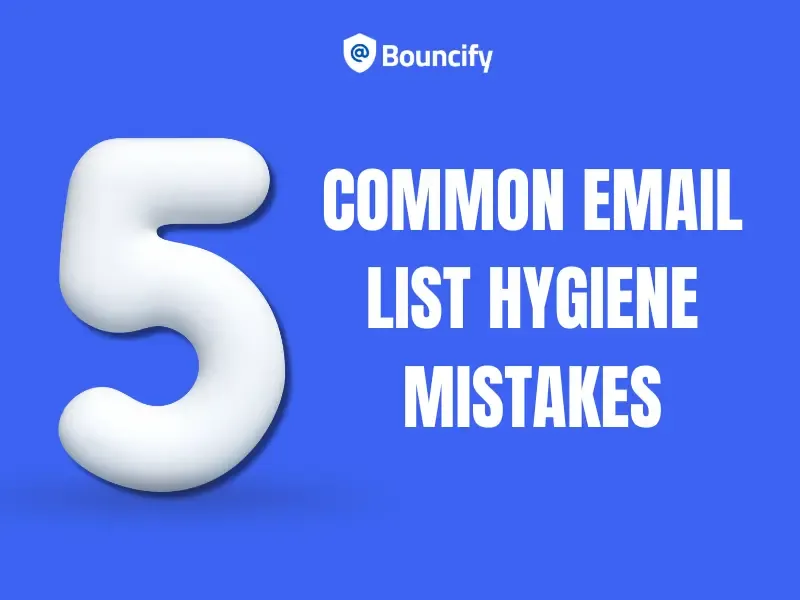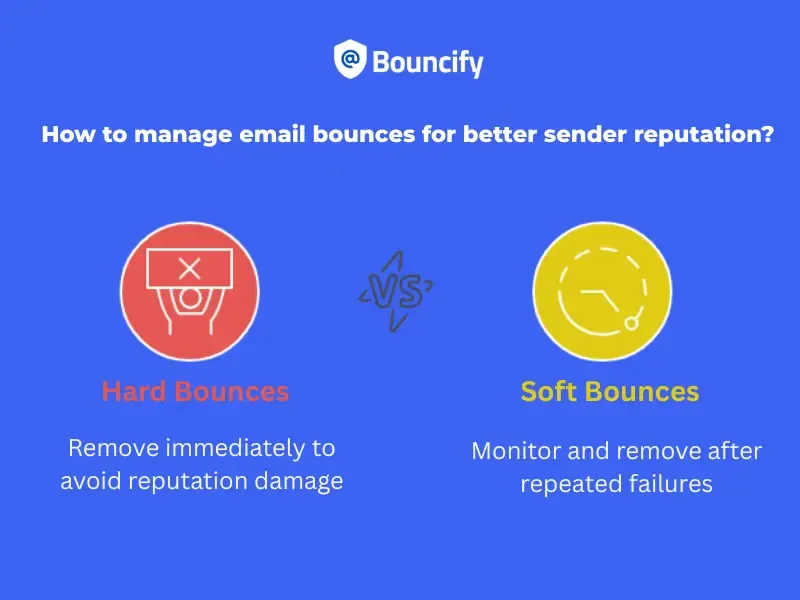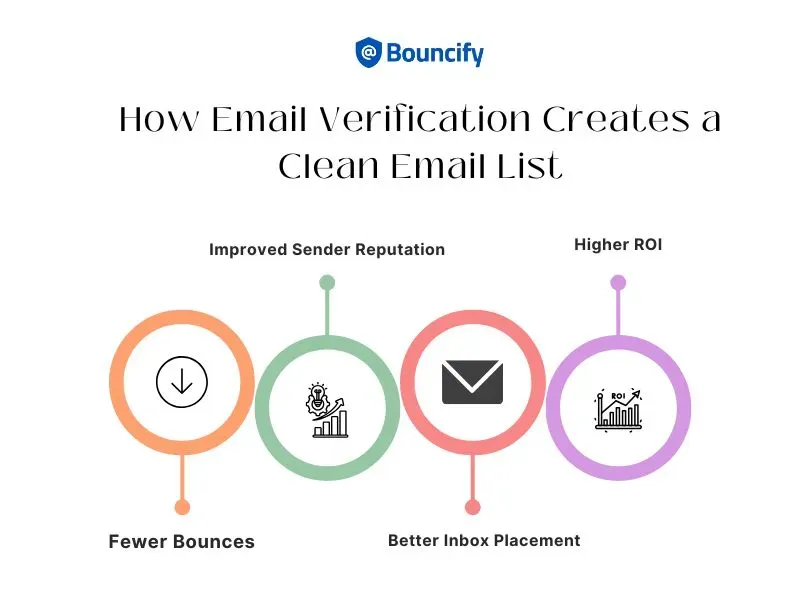5 Common Email List Hygiene Mistakes and How Verification Fixes Them

In the world of email marketing, the size of your list isn't the ultimate measure of success - the quality is. You can have the most brilliantly crafted campaign, but if it’s being sent to a list cluttered with invalid, outdated, or unengaged contacts, your efforts are wasted. This is where email list hygiene comes in, the practice of regularly cleaning and maintaining your subscriber list to ensure it’s healthy and effective.
Neglecting this crucial task can lead to a cascade of negative consequences, from plummeting deliverability rates to a damaged sender reputation and, ultimately, a lower return on investment (ROI). A healthy email program starts with a clean email list.

Ready to improve your email deliverability? Sign up now and verify your emails with us for free.
At Bouncify, we’ve seen it all. Here are five of the most common and costly email list hygiene mistakes marketers make, and how a proactive approach with email verification can turn things around.
1. Never Removing Inactive Subscribers
The Mistake: Many marketers hold onto every subscriber, fearing a smaller list means less reach. They continue sending emails to contacts who haven't opened or clicked a single message in months, or even years. This is a significant error in email list hygiene.
Why It's Harmful: Internet Service Providers (ISPs) like Gmail and Yahoo track engagement metrics to determine your sender reputation. Continuously sending to unengaged subscribers tells them your content isn't relevant or wanted, increasing the likelihood of your emails landing in the spam folder for your entire audience.Moreover, you're often paying your Email Service Provider (ESP) based on the number of contacts, meaning you're wasting money on people who aren't listening.
Example: A retail brand continues to send daily promotions to a subscriber who hasn't opened an email in over a year. The subscriber eventually gets annoyed and, instead of unsubscribing, marks the email as spam. This single complaint contributes to a higher overall spam complaint rate, damaging the brand's sender reputation.
2. Ignoring Hard and Soft Bounces
The Mistake: You notice bounce notifications trickling in after a campaign, but you don't take action to remove or investigate them. You assume it's just a small, insignificant percentage.

Why It's Harmful: Bounces are direct indicators of a problem with your email list.
- Hard Bounces are permanent delivery failures, usually due to an invalid or non-existent email address. These should be removed immediately. Failing to do so signals to ISPs that you are not practicing good email list hygiene, which can severely damage your sender reputation.
- Soft Bounces are temporary issues, like a full inbox or a server being down.While a single soft bounce isn't a red flag, repeated soft bounces from the same address often indicate an abandoned account and should also be removed.
Example: A B2B company sends a monthly newsletter. Several emails hard bounce because employees have left their jobs. By not removing these addresses, their bounce rate creeps up. Soon, their ESP throttles their sending speed, and their deliverability to valid prospects suffers.
3. Relying Solely on a Single Opt-In Process
The Mistake: You make it as easy as possible for someone to subscribe - they enter their email address once and are immediately added to your list. While this can grow your list quickly, it opens the door to low-quality contacts.
Why It's Harmful: A single opt-in process doesn't verify that the email address is valid, typo-free, or even belongs to the person who entered it. This can lead to a list filled with:
- Typos: john.doe@gnail.com instead of gmail.com.
- Fake Emails: asdf@asdf.com.
- Spam Traps: Fake email addresses used by ISPs to identify spammers. Hitting even a few of these can get you blacklisted.
Example: A lifestyle blog uses a single opt-in form. A user accidentally misspells their email address. Every email sent to that address results in a hard bounce. Another user enters a disposable email address they never check, becoming a permanently inactive subscriber from day one.
4. Purchasing or Renting Email Lists
The Mistake: In a rush to grow their audience, marketers are tempted to buy or rent a list of "qualified" leads. This is one of the most detrimental mistakes you can make for your email marketing program.
Why It's Harmful: Purchased lists are a minefield of problems. These individuals never opted in to hear from you, making your emails unsolicited and likely to be marked as spam.These lists are often outdated and filled with invalid addresses, recycled spam traps, and people who have no interest in your product or service.Sending to such a list is the fastest way to destroy your sender reputation and potentially violate anti-spam laws like CAN-SPAM.
Example: A startup buys a list of 10,000 "industry contacts." Their first email blast results in a 25% bounce rate and a spam complaint rate of 2% (the industry standard is below 0.1%!). Their domain is quickly blacklisted by major ISPs.
5. Performing "Spring Cleaning" Only Once a Year
The Mistake: You treat email list hygiene as a once-a-year task. You let your list degrade for 11 months before finally running a clean-up campaign.
Why It's Harmful: Your email list is not a static asset; it decays naturally over time. On average, mailing lists depreciate by about 22% every year as people change jobs, abandon old email addresses, or simply lose interest.Waiting too long to clean your list means you are consistently sending to a growing number of bad addresses, damaging your sender score with every campaign.
Example: An e-commerce store waits until their big Black Friday sale to clean their list. By then, hundreds of email addresses have become invalid. Their crucial holiday campaign suffers from poor deliverability, landing in spam folders instead of inboxes, and they miss out on significant revenue.
How Email Verification Creates a Clean Email List
The good news is that all these mistakes can be rectified with a robust email verification process. This is where a service like Bouncify becomes an indispensable tool for smart marketers.

Email verification is the process of checking an email address to ensure it is valid, active, and can receive messages. Here’s how it directly solves the problems above:
- Fewer Bounces: By identifying and removing invalid, fake, and misspelled email addresses before you send,Bouncify drastically reduces your bounce rate. This is a powerful, positive signal to ISPs.
- Improved Sender Reputation: A clean email list with low bounce rates and high engagement protects your sender reputation.This tells ISPs you are a legitimate sender, which is crucial for achieving high inbox placement.
- Better Inbox Placement: With a strong sender reputation, your emails are far more likely to land in the primary inbox, rather than the spam or promotions folder. This directly leads to higher open rates and engagement.
- Higher ROI: By focusing your efforts and budget on a clean email list of engaged subscribers, you stop wasting money on sending to dead-end contacts.This leads to better campaign performance, higher conversion rates, and a tangible increase in your marketing ROI.
Actionable Tips to Maintain a Clean Email List
Beyond using a verification tool, here are some best practices for ongoing email list hygiene:
- Implement Double Opt-In: Require new subscribers to confirm their email address by clicking a link in a confirmation email. This ensures you get valid, engaged contacts from the start.
- Verify at Point of Capture: Use a real-time verification API on your signup forms to catch typos and invalid emails before they ever enter your system.
- Automate List Cleaning: Don't wait for an annual cleanup. Integrate an email verification service to scrub your list regularly—ideally on a quarterly or even monthly basis.
- Run Re-engagement Campaigns: Before removing long-term inactive subscribers, send them a targeted "win-back" campaign to see if they're still interested. If they don't respond, it's time to let them go.
- Make Unsubscribing Easy: A clear and simple unsubscribe process is not only required by law but is also good for your list health. It's better to lose a subscriber than to gain a spam complaint.
Conclusion: Make Email List Hygiene a Priority
Your email list is one of your most valuable marketing assets, but only if it's well-maintained. By avoiding common mistakes and embracing proactive email list hygiene, you pave the way for better deliverability, stronger engagement, and a healthier bottom line.
Don't let a dirty list undermine your marketing success. Start building a clean email list today.

Ready to improve your email deliverability? Sign up now and verify your emails with us for free.
Ready to see the difference a clean list can make? Try Bouncify for free and get 100 verification credits on us!